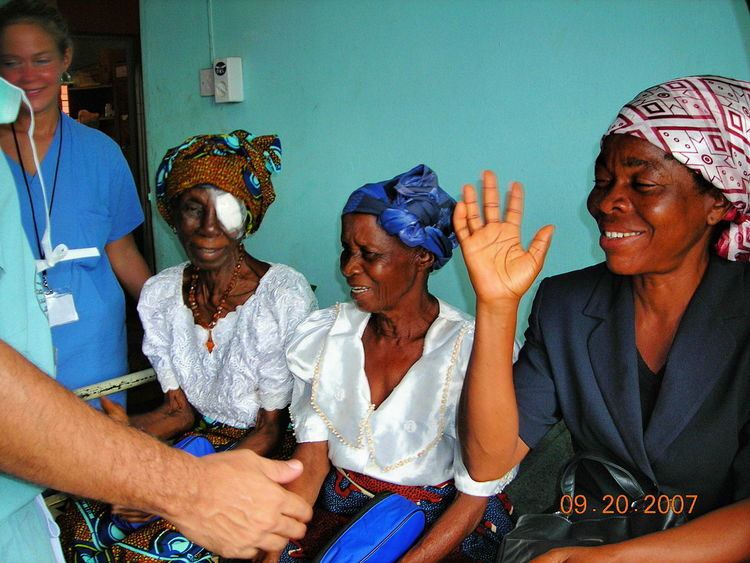Founded August 26, 1974 | Focus Vision Care | |
 | ||
Location Santa Barbara, California Area served International and Local Slogan 'Restoring sight and transforming lives worldwide since 1974' | ||
SEE International (or "Surgical Eye Expeditions" International) is a nonprofit humanitarian organization based in Santa Barbara, California. Founded in 1974, SEE International connects over 650 volunteer ophthalmologists and medical professionals to host clinic sites worldwide. Its objective is to provide sight-restoring surgeries in communities that are overwhelmed with the large number of blind individuals who cannot afford surgery. The organization is headed by President/CEO Randal Avolio, along with a 16-member Board of Directors. In the United States, it is classified by the IRS as a 501(c)(3) tax-exempt charity. It is a GuideStar Platinum Participant.
Contents
- International
- The Need for Cataract Surgery
- Manual Small Incision Cataract Surgery MSICS
- Local
- Awards and recognition
- Global Partners
- References
SEE's mission statement is, "To provide medical, surgical and educational services by volunteer ophthalmic surgeons with the primary objective of restoring eyesight to disadvantaged blind individuals worldwide."
International
SEE International coordinates short-term medical expeditions all over the world at the request of ophthalmologists in host countries where access to vision care is scarce. SEE International’s volunteer ophthalmologists work closely with the host eye surgeons to perform safe and quality sight-restoring surgeries.
In 2015 alone, SEE International performed over 15,000 surgeries in 39 countries around the world. Over the course of 40 years SEE has screened approximately 3.8 million individuals, and completed over 460,000 surgeries in over 80 different countries.
SEE expeditions typically take place over the course of one week. All teams are invited by the local health authority from the host country. SEE’s international clinic coordinators work with the host ophthalmologists three to six months in advance to coordinate logistical details and to ensure the availability of proper facility, equipment, supplies, support and staff.
The Need for Cataract Surgery
SEE International’s primary focus of cataract surgery is one of the most cost-effective of all health interventions. Cataracts cause nearly half of the world’s loss of sight, and are surgically correctable. Except for the most developed countries, cataracts remain the leading cause of blindness in all regions of the world. With a 30-minute surgery and the patient under local anesthetic, a volunteer SEE surgeon can restore the sight of a person who has been blind with cataracts for 5, 10 or even 20 years.
Manual Small Incision Cataract Surgery (MSICS)
Cataract surgeries in developing countries require a technique that is not normally practiced in the United States. Because of the density of the cataracts and the lack of infrastructure for sophisticated equipment, a manual process must be utilized in many developing countries. While ophthalmologists have traditionally employed the extracapsular cataract extraction (ECCE) manual method, this technique requires a relatively large incision made in the cornea which requires sutures. With the newer MSICS procedure, a much smaller incision is made that is also self-sealing. Skilled surgeons can perform twice as many surgeries in the same amount of time with the MSICS procedure compared to ECCE. In addition, patients typically have better post-op visual acuity, less astigmatism, fewer incidences of infection and heal faster through this process.
As part of SEE International’s ongoing commitment to patient care and affiliate ophthalmologists, and because of all the benefits of Manual Small Incision Cataract Surgery, SEE International has begun to train ophthalmologists in the technique through a one-day course held one to two times a year at the SEE offices in Santa Barbara.
Local
SEE International established the Santa Barbara Vision Care Program (SBVCP) in the 1980's, in response to the population within SEE’s own local community that could not afford vision care. The SBVCP saves eyesight in patients through early detection and to provide sight-restoring surgery to those in need. In 2015, the SBVCP provided services for 1,424 low-income and uninsured patients in Santa Barbara County.
Awards and recognition
In the December 10, 2001 issue of Forbes, SEE International was cited in the Charity Investment Guide for its 99% efficiency as a charity, meaning that financially almost nothing is lost to overhead.
On June 22, 2015, the United Nations General Assembly announced that SEE affiliate Dr. Helena Ndume was selected to receive the first-ever United Nations Nelson Rolihlahla Mandela Prize. According to General Assembly President Sam Kutesa:
The prize recognizes the achievements of those who dedicate their lives to the service of humanity by promoting UN purposes and principles while honouring Nelson Mandela’s extraordinary life and legacy of reconciliation, political transition and social transformation.
In 2016, the International Agency for the Prevention of Blindness (IAPB) recognized SEE volunteer Dr. Janak M. Shah, M.D., as an Eye Health Hero. Dr. Shah has collaborated with SEE on over 140 ophthalmic expeditions worldwide, the most out of any SEE surgeon to date. The purpose of the Eye Health Heroes program is "to celebrate eye care practitioners and front line staff whose everyday efforts behind the scenes are making a real difference towards Universal Eye Health." Dr. Shah and other Eye Health Heroes will be recognized at the 10th General Assembly of the IAPB, in Durban, South Africa, October 27-30, 2016.
Global Partners
Corporate and foundation partners support SEE through in-kind medical donations and cash grants.
